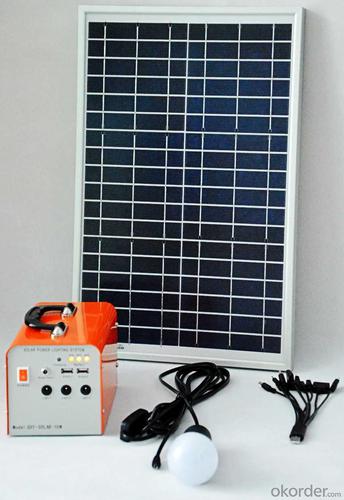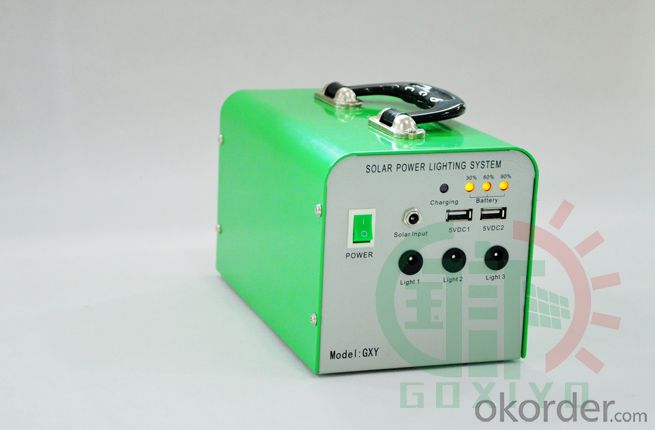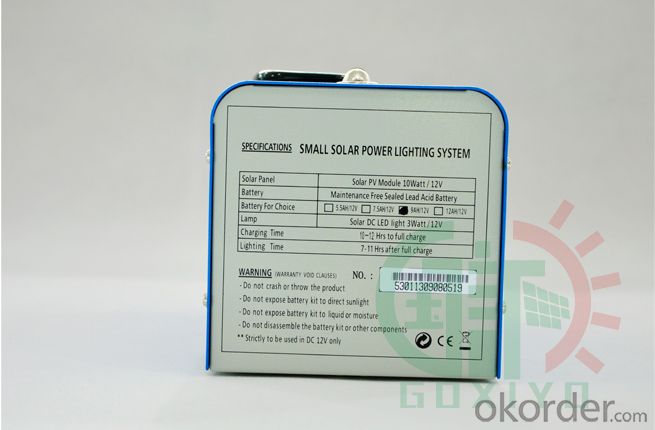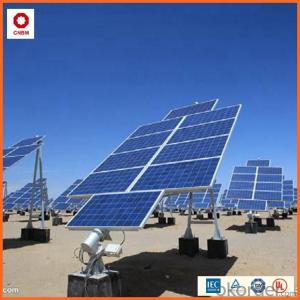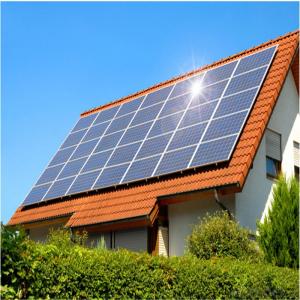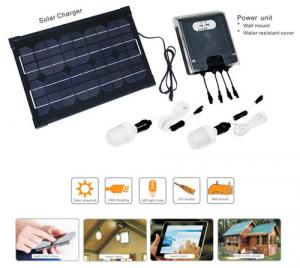Scudder Solar Energy Systems 30W Solar Power Generation System - Solar Field Charging Lighting System
- Loading Port:
- Shekou
- Payment Terms:
- TT OR LC
- Min Order Qty:
- 1 set
- Supply Capability:
- 9999 set/month
OKorder Service Pledge
OKorder Financial Service
You Might Also Like
30W solar generator system
This solar power generator system is designed with compact and lightweight body, and the battery and solar special charge and discharge controller are integrated, which is convenient to use. System is widely used in home lighting, outdoor lighting, and with USB output port, you can give all kinds of mobile phones, MP3, cameras and other electronic digital products charge. This product is equipped with solar panels, especially for non electric lighting, but also the ideal lighting tool for camping.
20Ah DC solar power system, small Huxing design. Solar power, clean, environmentally friendly.
The system is usually used for home lighting /interior lighting.
Beautiful appearance, compact size, easy to carry。






Quick Details | |||
Place of Origin: | Guangdong,China (Mainland) | Brand Name: | HYTN |
Model Number: | HYTN-SMP30 | Output Voltage (V): | 12 |
Specification: | Normal | Application: | Home |
Work Time (h): | 24-26 H | Load Power (W): | 3w |
Solar Power (W): | 30w | Work Time (h): | 24-26 H |
Name: | 30w grid solar system | Other name: | new style 10w grid solar system |
Solar Panel: | 30W 18V | Battery: | 12AH 12V |
USB Connector: | 5V 2000MA | DC output: | 12V 1500MA |
LED lamp: | 3w | DC Cable: | 5 meter DC cable, 5.5*2.1mm |
Charging time: | 5-7 H | Working time: | 24-26 H |
Packaging & Delivery | |||
Packaging Details: 30w grid solar system Packing:530mm*398mm*305mm, Carton box 14.0KG | |||
Delivery Detail: 15 - 35 days | |||
Specifications | |||
30w grid solar system | |||
Product Description | |||
Specification of 30w grid solar system: | |||
Solar Panel | 30w, 18v, High efficiency polycrystalline solar panel, with 25 years working life time, framed with strong alluminum alloy, easy to carry around. | ||
Battery | 12AH,12V,Sealed maintenance-free lead-acid battery | ||
USB Connector | (5V,2000MA),2pcs, work with cell phone, MP3,MP4,MP5 etc | ||
DC output | (12V,1500MA),could drive 12DV fan or other DC devices. | ||
Shell | 1.0mm thickness iron box coated | ||
LED lamp | 3w high effiency energy saving LED bulb. | ||
Battery Display | LED display showing battery volume | ||
DC Cable | 5 meter DC cable, 5.5*2.1mm. Connecting solar panel with power bank and 5 meter cable, 5.5*2.5mm,connecting LED lights | ||
Mobile Charging Cable | Various most commonly used USB charging adaptors for you to charge all kinds of mobile phones | ||
Charging,Using Time | 5-7 hours charging time,24-26 hours working time with 3w LED | ||
Accessories | 1 power bank, 1 solar panel with 5 meter cable, 1 3w LED bulb with 5 meter cable, multi-adaptor USB cable, 1 copy of manual. | ||
Packaging | 530mm*398mm*305mm, 14.0KG | ||
Range | Camping,power back-up, hunting, fishing, Charging mobile phones, lighting home and other outdoor activities. | ||
- Q: Can a solar energy system be installed in an area with a high lightning risk?
- Indeed, it is feasible to install a solar energy system in an area prone to frequent lightning strikes. Nevertheless, it is crucial to adopt adequate precautions and safety measures in order to mitigate any potential hazards. One viable option is to incorporate lightning protection systems that redirect the electrical charge away from the solar panels, inverters, and other equipment. Moreover, grounding systems and surge protectors can be utilized to offer supplementary protection. To ensure compliance with the requisite safety standards of the area, it is imperative to seek guidance from a qualified professional who can evaluate the specific risks and devise an appropriate system design.
- Q: Can solar energy systems be used in powering community centers or social organizations?
- Absolutely, community centers or social organizations can definitely utilize solar energy systems to power their facilities. Solar energy is an eco-friendly and renewable power source that can cater to various electricity needs such as lighting, heating, and running electrical appliances. To meet the electricity requirements of their members or visitors, community centers and social organizations often consume a significant amount of energy. By installing solar panels on their rooftops or in nearby open spaces, these organizations can generate their own electricity and reduce their reliance on the traditional power grid. One of the major advantages of utilizing solar energy systems is the long-term cost savings they offer. Although the initial installation costs may be higher compared to conventional power sources, solar panels have a lifespan of 25-30 years and entail minimal maintenance. Consequently, over time, the investment made in solar energy systems can be recouped through reduced electricity bills. Additionally, solar energy systems are environmentally friendly as they produce no greenhouse gas emissions during operation. By harnessing solar power, community centers and social organizations can play a role in mitigating climate change and diminishing their carbon footprint. In areas prone to frequent power outages, solar energy systems can provide a reliable source of electricity. By incorporating battery storage systems, excess solar energy can be stored and utilized during periods of low or no sunlight, ensuring uninterrupted power supply to the community center or social organization. Furthermore, solar energy systems can serve as an educational tool for social organizations to raise awareness about renewable energy and sustainability. By showcasing the advantages and viability of solar power, these organizations can inspire community members to consider adopting clean energy solutions in their own homes and businesses. In conclusion, solar energy systems are a feasible and sustainable option for powering community centers or social organizations. They offer cost savings, environmental benefits, reliability, and educational opportunities. By embracing solar power, these organizations can set an example and contribute to a more sustainable future.
- Q: Can solar energy systems be used in powering amusement parks?
- Yes, solar energy systems can be used to power amusement parks. Solar panels can be installed on the roofs of buildings, parking structures, or in open spaces within the park to generate electricity from the sun. This renewable energy source can help reduce the park's reliance on traditional grid power, lower operating costs, and decrease its carbon footprint. Additionally, solar energy systems can provide a reliable and consistent source of power, making them suitable for meeting the electrical demands of amusement parks.
- Q: What are the benefits of using solar energy systems?
- There are several benefits of using solar energy systems. Firstly, solar energy is a renewable and sustainable source of power, meaning it will never run out. Secondly, solar energy is clean and does not produce harmful greenhouse gas emissions, making it environmentally friendly. Additionally, using solar energy can help reduce electricity bills as it allows homeowners and businesses to generate their own electricity. Solar energy systems also require minimal maintenance and have a long lifespan, providing a reliable and cost-effective energy solution. Overall, utilizing solar energy systems contributes to a greener future, cost savings, and energy independence.
- Q: Can a solar energy system be installed on a building with a flat roof?
- Yes, a solar energy system can be installed on a building with a flat roof. Flat roofs provide an ideal surface for mounting solar panels, as they offer a level surface and provide ample space for installation. Furthermore, flat roofs often have unobstructed sun exposure, which is crucial for maximizing the efficiency of solar panels.
- Q: How do solar energy systems affect property values?
- Solar energy systems can have a positive impact on property values. Studies show that homes equipped with solar panels tend to sell at a higher price and faster than those without. This is primarily because solar systems reduce or eliminate electricity bills, resulting in long-term savings for homeowners. Additionally, solar energy is seen as a desirable and eco-friendly feature, appealing to environmentally conscious buyers. Overall, investing in solar energy systems can increase property values and attract potential buyers.
- Q: Can solar energy systems be used for cooking?
- Yes, solar energy systems can be used for cooking. Solar cookers or solar ovens harness the energy from the sun to heat and cook food. They are a sustainable and eco-friendly alternative to conventional cooking methods as they utilize clean and renewable solar energy. Solar cookers can be used for various cooking tasks, such as boiling, baking, and even frying, making them a viable option for those seeking to reduce their carbon footprint and dependency on fossil fuels.
- Q: What are the different financing options for solar energy systems?
- There are several financing options available for solar energy systems, including purchasing the system outright with cash, taking out a solar loan, leasing the system, or entering into a power purchase agreement (PPA). Each option has its own advantages and considerations, such as upfront costs, ownership of the system, maintenance responsibilities, and potential savings. It is important to research and compare these options to determine which one aligns best with your financial goals and circumstances.
- Q: How much sunlight is needed for a solar energy system to be effective?
- A solar energy system can be effective with as little as 5 hours of direct sunlight per day, although the ideal range is typically 6 to 8 hours.
- Q: Can solar energy systems be used in powering concert halls or auditoriums?
- Yes, solar energy systems can certainly be used to power concert halls or auditoriums. The use of solar energy in large venues like concert halls and auditoriums has become increasingly popular due to its numerous benefits. Solar panels can be installed on the roof or surrounding areas of the venue to capture sunlight and convert it into electricity. This renewable energy source can then be used to power all the electrical equipment and lighting systems within the concert hall or auditorium. One of the main advantages of using solar energy systems in these venues is the potential cost savings. Concert halls and auditoriums often consume large amounts of electricity, particularly during events and performances. By harnessing solar power, these venues can significantly reduce their dependence on the traditional power grid and lower their energy bills. Additionally, solar energy systems require minimal maintenance once installed, which further contributes to the long-term cost-effectiveness. Moreover, integrating solar energy into concert halls and auditoriums aligns with the growing global focus on sustainability and reducing carbon footprints. By utilizing renewable energy sources like solar power, these venues can significantly decrease their greenhouse gas emissions and promote a more environmentally friendly approach to energy consumption. This not only benefits the venue itself but also contributes to the overall sustainability goals of the local community and society as a whole. However, it is important to consider that the size and power requirements of concert halls and auditoriums may require a significant investment in solar panels and associated equipment. The venue's energy demand, the available space for installation, and the local climate are all factors that need to be assessed during the planning stage. It is crucial to ensure that the solar energy system is properly sized to meet the energy needs of the venue and that it is designed to withstand the specific weather conditions of the location. In conclusion, solar energy systems can indeed be used to power concert halls or auditoriums. The benefits of using solar power in these venues include cost savings, environmental sustainability, and reducing reliance on the traditional power grid. With careful planning and installation, solar energy can provide a reliable and efficient source of electricity to meet the energy demands of such large-scale venues.
Send your message to us
Scudder Solar Energy Systems 30W Solar Power Generation System - Solar Field Charging Lighting System
- Loading Port:
- Shekou
- Payment Terms:
- TT OR LC
- Min Order Qty:
- 1 set
- Supply Capability:
- 9999 set/month
OKorder Service Pledge
OKorder Financial Service
Similar products
Hot products
Hot Searches
Related keywords






